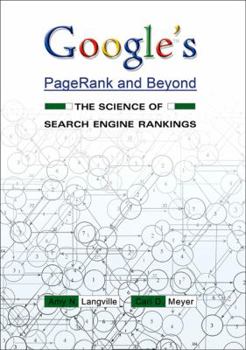Google's Pagerank and Beyond: The Science of Search Engine Rankings
Select Format
Select Condition 
Book Overview
Why doesn't your home page appear on the first page of search results, even when you query your own name? How do other web pages always appear at the top? What creates these powerful rankings? And... This description may be from another edition of this product.
Format:Hardcover
Language:English
ISBN:0691122024
ISBN13:9780691122021
Release Date:July 2006
Publisher:Princeton University Press
Length:240 Pages
Weight:1.55 lbs.
Dimensions:0.8" x 7.0" x 10.0"
Customer Reviews
5 ratings
Probability Transition Matrix, Markov Chain, and Stationary Vector
Published by Thriftbooks.com User , 15 years ago
A web search engine has six major components. The components are (1) crawler module, (2) page repository, (3) indexing module, (4) indexes, (5) query module, and (6) ranking module. The ranking module takes the set of relevant pages and ranks them according to both the content score and the popularity score. The popularity score is the focus of Amy N. Langville and Carl D. Meyer's "Google's PageRank and Beyond: The Science of Search Engine Rankings." The popularity score of a web page is determined by Web pages' hyperlink structure. Brin and Page`s PagerRank philosophy is that a page with more recommendations must be more important than a page with a few links. Or a web page is more important if it is pointed to by other important page. Brin and Page then build a normalized hyperlink matrix (H). With the adjustments named stochasticity and primitivity, a Google matrix (G) is obtained, which is, in fact, a probability transition matrix of a Markov chain. The desired ranking of the web pages is the stationary vector of the matrix G or the solution of the corresponding linear homogeneous system. To calculate the ranking vector is not an easy task, for the matrix G has 8.1 billion rows and 8.1 billions columns. The matrix is growing everyday as the number of web pages grows everyday. The book consider several major large-scale implementation issues such as storage, convergence criterion, accuracy, dangling nodes, and back button modeling. Accelerating methods are presented as well. They are the adaptive power method, extrapolation, and aggregation. Once the ranking vector is calculated, it has to be updated periodically. However, there is no effective and efficient update method available other than calculating from scratch. Other ranking methods such as HITS and SALSA are introduced. They are both query dependent. They have both the hub and authority scores. They are both easier to spam than PageRank. Several interesting Matlab programs are provided. One could use them crawl the web, build the matrices, and accelerate the calculation of the stationary vector. This is a wonderful book with timely technical material, entertaining asides, and a cute book cover. Best of all, the primary author is a lady. I am looking forward to read more books like this.
An excellent introduction into the algorithms and mathematical bases underlying Pagerank and other l
Published by Thriftbooks.com User , 16 years ago
The authors subdivide the book into two main sections: the first few chapters, which are conversational in the manner in which they address pagerank and similar algorithms, and the subsequent chapters, which grow increasingly mathematical. Both authors have strong backgrounds in mathematics, hence that focus. Understanding that, the book is very approachable, lucid and useful in understanding the treated subject matter.
truly pagerank and beyond
Published by Thriftbooks.com User , 17 years ago
Great book describing the algorithms that made current search engines so useful and popular. The book describes the math behind the pagerank and HITS algorithms, supported by MATLAB code. Wonderfully written! Do not buy this book if you want to know how to use search engines, only if you want to understand them!
practical and fun
Published by Thriftbooks.com User , 17 years ago
Great work! I wish I read it before I start my Ph.D. study. Pros: 1) Precise and intuitive description of the search algorithm 2) Plenty of interesting stories making mathematics fully applicable in practice 3) Sample Matlab code available Cons: This is actually a perfect book. But one needs to have basic linear algebra to appreciate its value. If you are looking for "SEO", you are in a wrong spot. But if anyone wonder how Page and Brin turn math into treasure, read it!
surveys search techniques
Published by Thriftbooks.com User , 17 years ago
Langville and Meyer have done a superb job describing both Google's technical foundations, and the broader subject of how search engines rank pages. Over half the book is devoted to explaining the maths and rationales behind PageRank. The level of maths is understandable to those who have done some university level courses on linear algebra (i.e. matrices). The book also has considerable value in analysing what other organisations (like search engines) and researchers have cobbled together. It gives a useful summation of the state of the research, circa 2006. Essentially, everyone seems to focus on link analysis, after Google revolutionised the industry in 1998 by using this. It blew away the previous leader, AltaVista. It is true, as the authors point out, that most of the material here has already been published. But as discrete events, scattered through various scientific journals and websites. You can certainly get explanations of PageRank on several websites. But the mathematical depth and reliability of those discussions can vary with the site. The book is far handier. It is a good starting point, if you are interesting in devising your own search methods.




